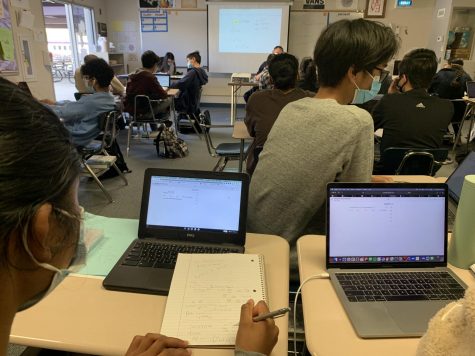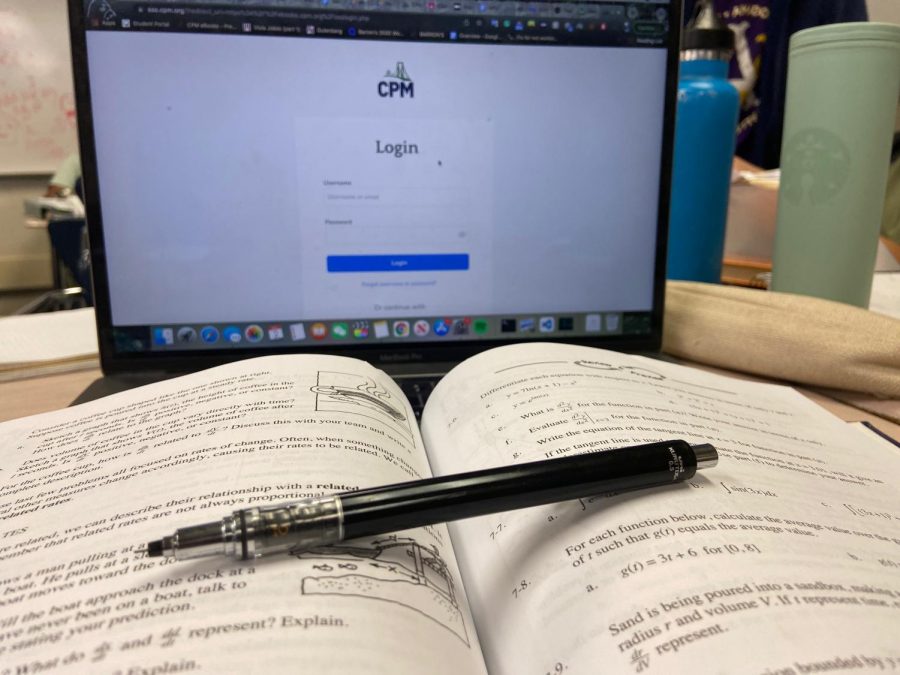An evaluation of the CPM math curriculum: what can be done?
Many Amador math classes use CPM, ranging from Algebra 2 classes to Calculus.
December 7, 2021
Students taking honors or AP math courses at Amador, from Honors Algebra II to AP Calculus, are all familiar with CPM, the textbook they use during every class period.
What is CPM
CPM stands for “College Preparatory Mathematics,” created around 1990 by a group of teachers in Sacramento to revolutionize math teaching. According to CPM’s official website, the curriculum was designed using three “research-based principles”: problem-based lessons, group interactions, and mastery of concepts over time.
What do these principles mean in real life? The first two constitute the classwork: unlike traditional textbooks that offer definitions, explanations, and sample problems to teach a concept, CPM classwork consists solely of problems without sample solutions, and students are supposed to learn new concepts by solving these problems with their table groups.
The “mastery of concepts over time” means that the homework is repetitive and cumulative, containing concepts introduced long ago.
CPM at Amador Valley
Many students are appalled by the idea that everything they learn is through solving problems with no example solutions. They think that the principle of self-learning can be very unreliable because they are expected to arrive at most of the knowledge themselves with limited help from teachers.
Richard Li (‘22), who used CPM last year for Calculus and is currently taking Multivariable Calculus using a traditional college textbook, prefers his current classwork style over CPM.
“If I have to self-learn it, I can even get the formulas wrong. I figure out the formula proofs later with a traditional lecture-style class, and I still learn the concepts thoroughly,” said Li.

The group interactions principle is especially unrealistic because, contrary to the CPM vision, many students simply don’t have the motivation to enthusiastically discuss and work with their group mates, who can all be confused over a concept and fail to help each other understand it.
“If I can buy a set of textbooks and self-study calculus on my own, why am I attending it as a class in high school?” says Arthur Hua (‘22).
The CPM vision of students collaborating to learn effectively is not realistic because, in reality, the learning process is individual.
Students also aren’t big fans of the CPM’s homework problems, which reinforce ideas but, unfortunately, are also very repetitive. A new concept means the same types of problems involving the concept for the next several weeks or even months in the CPM homework sections.
“I think that to some extent it was helpful because it allowed me to efficiently solve the problems that appeared on the AP exam and it allowed me to make less silly errors. The experience was not particularly enjoyable,” says Li.
Regardless of the tediousness, CPM is almost a fool-proof curriculum that guarantees positive results. This is why teachers think that CPM is effective despite its flaws.
“I don’t hate CPM as much as a lot of students do because it does require you to do some work in your head that forces you to understand the material,” says Amador Math Teacher Charles Snyder.
Whether the tedious process is worth the result might be where the opinions of students, parents, and teachers differ the most. Parents and teachers might think that if students ultimately understand the concepts, the little boredom and repetitiveness are worth it because, after all, math is generally not seen as an exciting subject, and it is okay for students not to like math.
On the other hand, students, myself included, still blame CPM for making math more tedious than it has to be. The enjoyment of the learning process is as important as the result; CPM takes the joy out of learning and is a very rigid and standardized way to ensure that everyone gets about the same fruits, consisting mostly of test scores, regardless of their level of motivation.
It is not that the results aren’t worth it, but that these results can be achieved in better ways.
What can be done?

However, it is difficult to improve this situation. If the curriculum changed to foster interest for the unmotivated, it would, in turn, drag the motivated students behind.
If the curriculum focuses on more higher-level concepts that show the intricacy and beauty of math, it would only benefit the motivated students.
In the end, it is up to the student to use available resources, such as YouTube videos or online groups, and get the most out of them.
Textbooks shouldn’t be depended upon because no textbook is enough if the student doesn’t actively try to gain a deep understanding of the material. Everyone prefers a slightly different way of learning, so they should strive to meet their own needs.
CPM can absolutely be improved. Sometimes when doing homework, I personally want to edit the absurdly-worded questions with tedious calculations into something less dreadful.
However, CPM is not as terrible as most students think and can be used appropriately, with outside resources, to guarantee mastery.







Elizabeth C • Oct 25, 2023 at 8:46 pm
I had 2 children both highly capable in math exposed CPM in HS, and I can say without a doubt that CPM is the worst math curriculum ever developed. It encourages guessing, is highly inefficient, and relies on students “teaching“ each other with its emphasis on group work rather than individual mastery. Furthermore there is little to no data suggesting it is a more effective curriculum in terms of student achievement, which should be the primary criterion used to select a math curriculum. In fact many studies demonstrate it is inferior to other approach that incorporate more direct instruction. Teachers insinuating that students dislike CPM because it makes them think are missing the point -it makes them spend far too much time thinking about how to even approach the problems when so little direction has been provided. I am a physician and I can say with no reservation that if medical school curriculums used the same approach as CPM there would be no competent physicians
Brian N • Apr 12, 2023 at 5:15 am
CPM is a teacher’s dream: the curriculum, lesson plans, and pacing all laid out in front of them, and they are instructed to not be the center of the information gathering, and thus when kids ask if they have the correct answer, or even if they are on the right track with their thinking, the teacher is to not respond in the negative or positive. It’s all up to the students to decide. Then when the class is stuck, the teacher calls out a number, or a “huddle” and a smart kid from each table happens to be in that seemingly arbitrary group, and then those kids get slickly directed by the teacher, and then go back and try to lead the team of 4 into the right direction, without knowing truly if it is the right direction. I think lazy teachers will love this program, as they are instructed to say nothing but facilitate the group by saying, hhhhhmmmm, ok, i cant answer that, ask your team. And now since Covid hit, as test scores drop, and learning suffers, for a decade or so, teachers and schools will blame covid, but it’s really CPM.
Mr. Hedman • Feb 8, 2023 at 12:38 pm
Hi! I’m a math teacher at another school considering a CPM textbook. Your article was very helpful, thank you!
Mr. Espindula • Mar 21, 2022 at 5:15 pm
Very well written. CPM is for the top 5% that can teach themselves.
A book without examples… is just wrong.